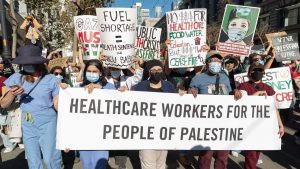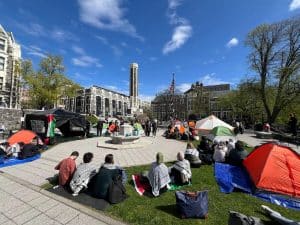Image by Julie Dermansky
Donald Trump’s nomination and election is the most recent chapter in an ongoing leadership struggle that began in the aftermath of the global recession and the 2008 Democratic electoral victory. Capital successfully beat back the first wave of middle-class radicalism in the Republican Party—the Tea Party—during the 2014 Congressional elections, but these rebels were not vanquished. They were radicalized.
Since the 1960s, the mass voter base of the Republican Party has been made up primarily of older, suburban, white, middle-class, small businesspeople, professionals, and managers, and a minority of older white workers. Until recently, the particular passions of the Party’s base —especially its hostility to the democratic gains of people of color, women, and LGBT people—could be contained. Minor concessions to the social conservatives on abortion, affirmative action, voter restrictions, and same-sex marriage/legal equality maintained their loyalty, while capitalists set the substantive neo-liberal agenda for the Republicans (and the Democrats as well). As in the Democratic Party, the non-capitalist elements of the Republican coalition were clearly junior partners to capital.
The Bush and Obama administrations’ bail-outs of banks, the auto industry, and some homeowners changed this dynamic, catalyzing a radicalization of the Republican electorate. The “Tea Party” began as an alliance between a grass-roots rebellion of older, white, suburban small-business people, professionals and managers, and elements of the capitalist class. While the middle-class ranks of the Tea Party railed against “corporate welfare” and “bailouts for undeserving homeowners,” in particular people of color with sub-prime mortgages, capitalists like the Koch brothers saw an opportunity to advance their libertarian agenda of defeating Obamacare and privatizing Medicare and Social Security pensions. [1] Broader layers of the capitalist class encouraged the Tea Party’s mobilizations as long as it targeted unions and social services, and supported the continued deregulation of capital.
This alliance continued through the 2010 Congressional elections, when the Republicans won a majority in the House and deprived the Democrats of their filibuster-proof “super majority” in the Senate.[2] Unlike the political establishment, the Tea Party right supported mass deportations and wasn’t fazed by the possibility of a Federal credit default. Capitalists had a different agenda. Capital wants a precarious migrant workforce without legal status and disciplined by selective deportations, to labor for substandard wages. While capital supports massive social spending cuts and a reduction of the Federal budget deficit, they cannot support any moves that would endanger the “full faith and credit” of the US state.
Capital wants a precarious migrant workforce without legal status and disciplined by selective deportations, to labor for substandard wages.
The uneasy alliance between the Tea Party and the capitalist class ended in the autumn of 2013. The campaign to “Fix the Debt,” launched in 2012, brought together dozens of former Senators and Congressmen and over one hundred fifty CEOs of US transnational corporations in support of a “grand bargain” to close corporate tax loop-holes and lower the overall tax rate in exchange for “restructuring” federal pensions, Medicare, Medicaid, and Social Security. The campaign garnered the support of Obama, the Democratic leadership, and mainstream Republicans, but the Tea Party refused to accept the compromise, sparking the government shut-down of late 2013. In 2014 capital waged primary campaigns against the Tea Party. The US Chamber of Commerce’s “Vote for Jobs” was effective in shaping the Republican Congressional primaries and the November 2014 general election. Only one Republican was elected to the Senate without the endorsement of the Chamber of Commerce.
Despite capital’s ability to undermine the Tea Party, the revolt of the Republican’s base did not end in 2014. Donald Trump’s “outsider” campaign for President marked a deepening of the right-wing radicalization of sections of the middle classes. When Trump announced his candidacy for the Republican nomination in June 2015, few political commentators took his campaign seriously. However, within a month of announcing for the Presidency, Trump was out-polling a crowded Republican field and he secured the party’s nomination in July 2016.
What made Trump unacceptable to the Republican establishment and their corporate backers was not merely his unabashed racism and misogyny, or his casual references to his penis size. Trump champions an economic nationalism that rejects central tenets of the bipartisan neo-liberal agenda that has impoverished segments of the middle and working classes. Capital was uneasy with Trump’s stance on immigration and his proposals to persuade creditors to accept less than full payment on their loans to the US government. [2] The corporate elite were further alienated by his ideas about foreign policy. Trump’s “America First” stance—rejected by the US corporate elite since the 1940s– threatens the alliance system which has maintained US dominance since World War II. [3]
Trump champions an economic nationalism that rejects central tenets of the bipartisan neo-liberal agenda that has impoverished segments of the middle and working classes.
The removal of political obstacles to the free movement of capital and goods—but not labor—has been a fundamental element of neo-liberal orthodoxy for well over thirty years. The entire US capitalist class and its political representatives in both the Democratic and Republican parties have promoted the liberalization of trade and investment. Trump blames NAFTA and other trade deals for the loss of US manufacturing jobs, and calls for tariffs as high as 40 percent on imports to protect US jobs against “unfair” competition—despite warnings that this could spark a global trade war that could damage the role of US corporations in the world economy. [5]
Trump’s nomination sent the majority of the capitalist class, including traditionally Republican capitalists, running to support the reliable neoliberal imperialist, Hillary Clinton. According to Opensecrets.org, Clinton received over 92 percent of corporate contributions in the 2016 election cycle, including over 80 percent of the contributions from finance, insurance, and real estate; communications/electronics; health care, defense and “miscellaneous business.”
So how did Trump win? Despite losing the popular vote by over 2 million votes, Trump swept the Electoral College. Voter participation among traditionally Democratic segments of the electorate fell. [6] African-Americans dropped from 13 percent of all voters in 2008 and 2012 to 12 percent in 2016. Households earning less than $50,000 per year, who made up 51 percent of the US population in 2014, dropped from 41 percent of voters in 2012 to 36 percent in 2016. The percentage of households earning over $100,000, a mere 17 percent of the population, rose from 28 percent to 33 percent of voters between 2012 and 2016.
Within these key categories, there were also small, but significant shifts in voter preference. While 60 percent of voters in households earning less than $50,000 a year voted for Obama in 2008 and 2012, Clinton’s share of these voters dropped to 52 percent. Clinton only won 88 percent of the black vote, down from 95 percent and 93 percent for Obama in 2008 and 2012. Especially alarming for the Democrats was their falling share of the Latino vote. The Democrats’ share of the Latino declined from 71 percent in 2012 to 65 percent in 2016. Finally, the percentage of union households voting Democratic fell from 58 percent in 2008 and 59 percent in 2012 to a mere 51 percent in 2016.
Trump’s ability to retain the core sectors of the Republican’s voter base since 1980—primarily the traditional (self-employed and small businesses with less than ten employees) and new (professionals, mangers, supervisors) middle classes, including evangelical Christians, and a minority of older, white workers—was clear in all of the exit polling. His margin of victory came from a small minority of voters who had supported Obama in 2008 and 2012. [7] Of 700 counties that had voted for Obama twice, nearly one-third (209) swung to Trump; and of 207 counties that Obama won once, almost 94 percent (194) went to Trump. The swing to Trump was concentrated in traditionally Democratic states of the Great Lakes and Midwest—the so-called “Rust Belt.” While Trump gained approximately 335,000 more votes than Romney among households earning less than $50,000 per year in these states. However, Clinton received 1.7 million fewer votes than Obama among the same group. [8] It was these miniscule shifts in voter preference that gave Trump his razor-thin margins in these key regions. According to one analysis, had about 100,000 Trump voters in these areas voted for Clinton instead, she would have swept the Electoral College.
Trump’s populist-nationalism appeals to elements of the older, white middle class who fear downward mobility into the working class. These folks believe they are “hard workers” who “play by the rules” and never ask for “handouts” (government subsidies, etc.) but are constantly falling behind socially and economically. They are threatened both by powerful economic and social elites and “line jumpers”—African-Americans, Latinos and women who benefit from affirmative action; and undocumented immigrants and refugees. [9]
Clearly, a minority of older, white workers also supported Trump. [10] Trumpism is the fruit of decades of “lesser evilism,” where the Left trails after the labor officials, who continually surrender to capital, while tailing after a rightward moving Democratic party in the name of “fighting the right.” Without a clear and potent independent working class political alternative—one rooted in mass struggles in workplaces and communities—more and more workers will see no alternative to the neo-liberal capitalist offensive other than white populist nationalism.
What can we expect from a Trump administration? [11] We can expect a continuation and intensification of the attacks on working people that every administration—including Obama’s—have carried out since the late 1970s. We should expect even more deportations of “criminal” undocumented immigrants (Obama set the record for deportation), more cuts to social services (Obama made the deepest cuts in food stamps), and the removal of remaining regulations on capital, especially on finance and energy production.
Despite the presence of Steve Bannon and other nationalist populists in the administration, it is highly unlikely that Trump’s promises to roll back neoliberal “free trade” agreements or to renege on US commitments to imperialist diplomatic and military alliances will come to fruition. Trump himself has already back-pedaled on his threats to deport all undocumented workers, reinstitute water-boarding, withdraw from the Paris Climate accords, indict Bill and Hillary Clinton, or ban all Muslims from entering the US. His proposals to renegotiate NAFTA and impose tariffs on China, withdraw from the negotiations on the Trans-Pacific Partnership, build a wall on the Mexican border, or shift US military and diplomatic alliances from NATO to Putin’s Russia will face concerted opposition from both the establishment dominated Republican Congress and the permanent officialdom of the Federal government.
Put another way, Trump will likely face the sort of structural-institutional obstacles social democrats face when attempting to implement anti-capitalist reforms through the capitalist state. This will, of course, demoralize many of his middle and working class supporters and make it easier for the mainstream Republicans to regain control of the party, possibly through the creation of a system of unelected ‘super-delegates’ like those the Democrats created in the 1970s.
The fight-back against Trumpism will have to take various forms—organized, collective anti-fascist defense against attacks; mass protest demonstrations, and, ultimately in struggles within the workplace.
While the Trump regime is not fascist, his election has encouraged the small groups of organized fascists and individual right-wingers. They believe they have the “wind at their back,” freeing them to assault people of color, immigrants, Muslims, queer folks and leftists. Through November 16—just one full week after Trump’s election—the Southern Poverty Law Center counted approximately seven hundred violent hate crimes in the US. [12]
The fight-back against Trumpism will have to take various forms—organized, collective anti-fascist defense against attacks; mass protest demonstrations, and, ultimately in struggles within the workplace. Strategically, new organizers need to understand that we cannot rely on either the Democrats or the forces of official reformism. While the labor officials and their allies may be more willing to mobilize against Trump than they were against Obama, we can expect them to “double down” on their support of the Democrats in the 2018 Congressional election.
The spontaneous protests in many cities and the growing campaign to wear safety pins as a sign of solidarity against racist and homophobic violence are promising beginnings. However, the danger is that these struggles, like the Wisconsin Uprising, Occupy, and Black Lives Matter, will be short lived and leave little independent organization in their wake.
The way forward for the left is rebuilding the militant minority – the layer of activists with a strategy and tactics that go beyond reformism – in workplaces and social movements. Without such a layer rooted among broader layers of working people the labor officials, Democratic Party politicos and the middle class leaders of the social movements will be able to continually derail and demobilize promising struggles – as they have for most of the last forty years.
The way forward for the left is rebuilding the militant minority – the layer of activists with a strategy and tactics that go beyond reformism – in workplaces and social movements.
Charlie Post teaches sociology at the City University of New York and is a long time socialist activist.
[1] Theda Skocpol and Vanessa Williamson, The Tea Party and the Remaking of Republican Conservatism (New York: Oxford University Press, 2013)
2] The following paragraphs are based upon Charlie Post, “[Why the Tea Party?” New Politics 53 (Summer 2012), “Whither the Republican Party?: The 2014 Elections and the Future of Capital’s ‘A Team’” Brooklyn Rail (December 18, 2014) and “The Future of the Republican Party” Jacobin (December 23, 2014)
[3] Binyamin Appelbaum, “Donald Trump’s Idea to Cut National Debt: Get Creditors to Accept Less” New York Times (May 6, 2016)
[4] David E. Sanger and Maggie Haberman, “In Donald Trump’s Worldview, America Comes First, and Everybody Else Pays,” New York Times (March 26, 2016); David E. Sanger, “Paul Ryan on Foreign Policy Is Closer to Hillary Clinton Than Donald Trump” New York Times (April 14, 2016); Mark Lander, “How Hillary Clinton Became a Hawk,” New York Times Magazine (April 21, 2016)
6] Voter participation by demographic group for [2008 and 2012 is drawn from Roper Center for Public Opinion Research at Cornell University and Data for 2016 is drawn from CNN Exit Polls.
7] Kevin Uhrmacher, Kevin Schaul and Dan Keating, “[These Obama Strongholds Sealed the Election for Trump” Washington Post (November 9, 2016) and Loren Collingwood, “The County-By-County Data on Trump Voters Shows Why He Won” Washington Post (November 19, 2016)
8] Konstantin Kilibarda and Daria Roithmayr, “[The Myth of the Rust Belt Revolt” Slate (December 1, 2016)
[9] Arlie Hoschild, Anger and Mourning on the American Right—A Journey to the Heart of the American Right (New York: New Press, 2016)
10] For an excellent analysis of white working class support for Trump see Juan Cruz Ferre, “[Trump, Racism and the Working Class” Left Voice (December 16, 2016)
[11] This analysis is presented in greater detail in C. Post, “We Got Trumped” International Socialist Review (Forthcoming 2017)
12] Hatewatch Staff, “[Update: Incidents of Hateful Harassment Since Election Day Now Number 701” Southern Poverty Law Center Hatewatch (November 18, 2016)











